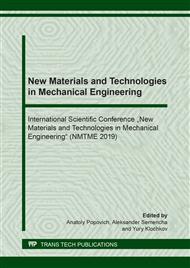[1]
M. Kuznetsov, I. Tsibulskiy, G. Turichin, A. Firsova, Hybrid Laser-Arc Welding of the High-Strenghth Shipbuilding Steels: Equipment and Technology, Physics Procedia. 89 (2017) 156-163.
DOI: 10.1016/j.phpro.2017.08.005
Google Scholar
[2]
M. Brede, P. Kujala, F. Roland, L. Manzon, J. Weitzenbock, Advanced Joining Techniques in European Shipbuilding Journal of Ship Production. 20, 3, (2004) 200-210.
DOI: 10.5957/jsp.2004.20.3.200
Google Scholar
[3]
U. Jasnau, J. Hoffmann, P. Seyfarth, YAG-laser – gas metal arc – hybrid welding: a chance for the use of the advantages of laser technology and flexible automation in shipbuilding and steel construction, International Conference on Robotic Welding, Intelligence and Automation, Shanghai, China, Conference Paper (2002).
DOI: 10.1007/978-3-540-44415-2_2
Google Scholar
[4]
B. Metschkow, F. Roland, Laser welded sandwich panels for shipbuilding and structural steel engineering Transactions on the Built Environment. 24, (1997) 183-194.
Google Scholar
[5]
H. Goda, K. Hirota, H. Koga, S. Nakayama, S. Terada, S. Tsubota, First Application of Hybrid Laser-Arc Welding to Commercial Ships, Mitsubishi Heavy Industries Technical Review. 47, 3, (2010) 59-64.
Google Scholar
[6]
K. Babkin, O. Klimova, V. Somonov, G. Turichin, E. Zemlyakov, High-Speed Direct Laser Deposition: Technology, Equipment and Materials, Equipment and Materials. Apr, (2016).
DOI: 10.1088/1757-899x/125/1/012009
Google Scholar
[7]
O. Grinin, A. Kuznetsov, M. Kuznetsov, J. Pevzner, G. Turichin, O. Velichko, Design of mobile hybrid laser-arc welding system on the base of 20 kW fiber laser, InLaser Optics, 2014 International Conference. Jun (2014) 1-1.
DOI: 10.1109/lo.2014.6886481
Google Scholar
[8]
E. Pozdeeva, G. Turichin, J. Tuominen, E. Zemlyakov, P. Vuoristo, Technological possibilities of laser cladding with the help of powerful fiber lasers, Metal Science and Heat Treatment. Jul, (2012) 3-4.
DOI: 10.1007/s11041-012-9470-y
Google Scholar
[9]
A. Gumenyuk, M. Rethmeier, Developments in hybrid laser-arc welding technology, Handbook of Laser Welding Technologies. (2013) 505-521.
DOI: 10.1533/9780857098771.3.505
Google Scholar
[10]
A. Lopota, G. Turichin, I. Tzibulsky, E. Valdaytseva, O. Velichko, Simulation and technology of hybrid welding of thick steel parts with high power fiber laser, Physics procedia. Jan, (2011).
DOI: 10.1016/j.phpro.2011.03.081
Google Scholar


